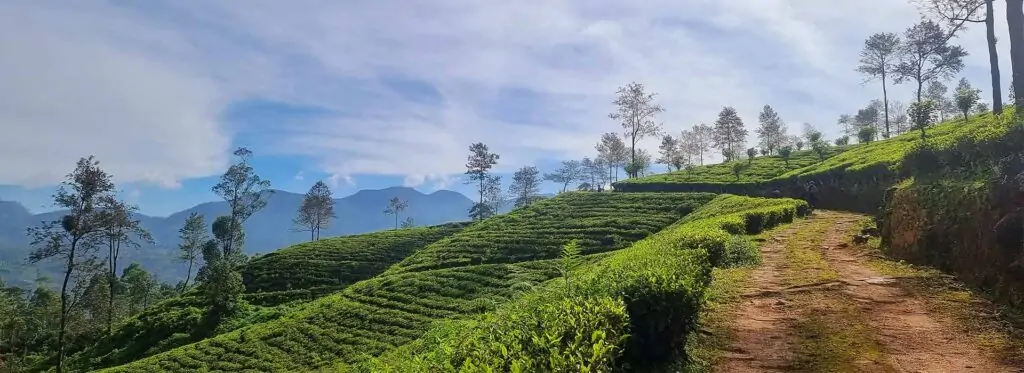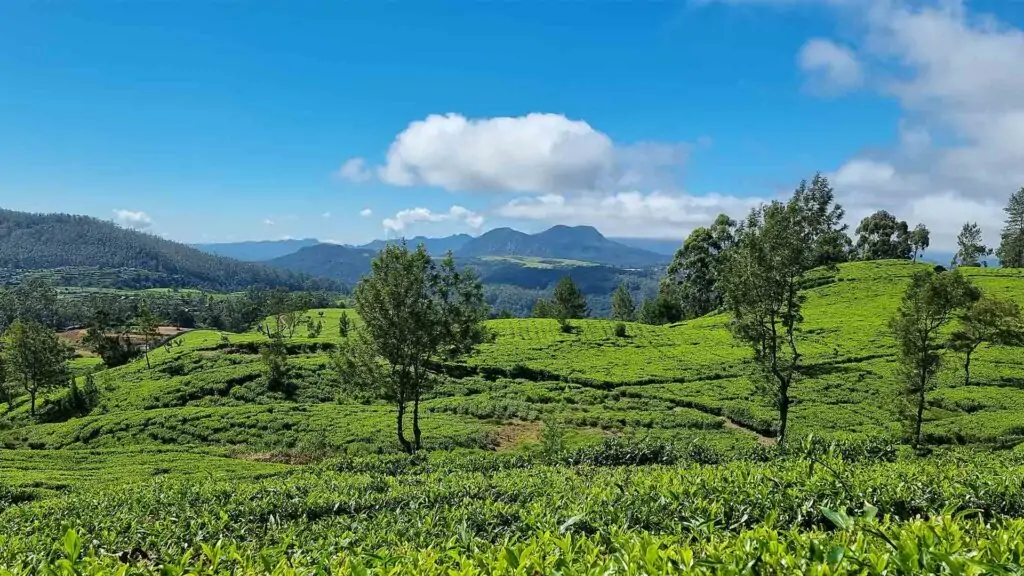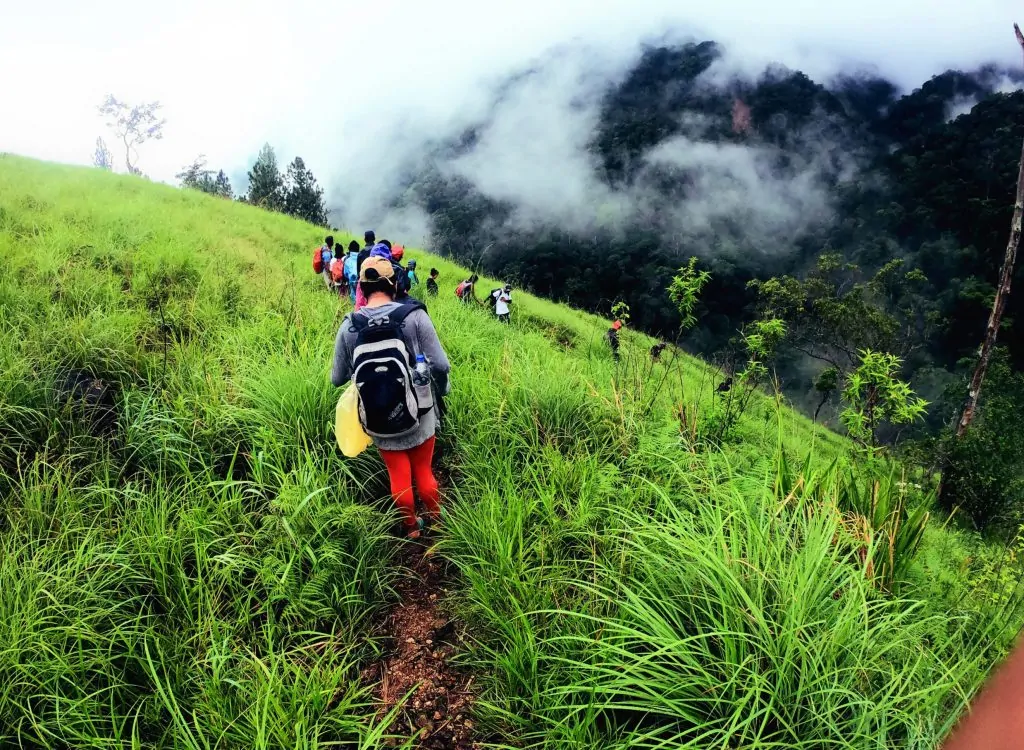Menu
A Guide to the Pekoe Trail Immerse Yourself in Sri Lanka’s Heart. Nestled amidst the lush greenery of Sri Lanka’s Central Highlands, the Pekoe Trail beckons adventure seekers and nature enthusiasts. This captivating 300-kilometer curated pathway, the first of its kind in the country, transcends the boundaries of a typical trek, offering a multi-faceted experience rich in cultural immersion, historical exploration, and breathtaking natural beauty.

A Legacy Steeped in Tradition
The Pekoe Trail derives its name from the Sinhalese word “pekoe,” signifying the highest grade of black tea. Unsurprisingly, the trail winds its way through the heart of Sri Lanka’s renowned tea country, where verdant plantations sprawl across the rolling hills, and the aroma of freshly brewed tea lingers in the air. The trail’s conception in 2017 marked a significant milestone in Sri Lanka’s tourism industry, aiming to showcase the country’s diverse landscapes and vibrant culture beyond the beaches. Designed by the Serendipity Trails project, the Pekoe Trail paves the way for future long-distance walking trails, promoting sustainable and responsible tourism practices.
A Tapestry of Enchanting Sights
Embark on a 22-stage journey, each offering a unique glimpse into the soul of Sri Lanka. Begin your exploration in the historic city of Kandy, a UNESCO World Heritage Site, and delve into the rich

tapestry of Buddhism at the Temple of the Tooth. As you ascend the highlands, lose yourself in the emerald embrace of tea plantations, witness the cascading beauty of waterfalls like Ramboda, and marvel at the panoramic vistas from viewpoints like Lipton’s Seat. The trail doesn’t shy away from showcasing the cultural heritage of the region. Explore ancient temples like Seetha Amman Kovil, dedicated to the Hindu goddess Sita, and delve into the colonial past at the British Garrison Cemetery. Quaint villages dot the landscape, offering opportunities to interact with the warm and welcoming locals, experience traditional ways of life, and indulge in authentic Sri Lankan cuisine. Beyond the Path: A Plethora of Activities While traversing the Pekoe Trail itself is an enriching experience, the surrounding areas offer a plethora of activities to further enhance your journey.
● Tea experiences: Embark on a guided tour through a working tea plantation, witness the meticulous process of tea production, and savor a cup of freshly brewed Ceylon tea amidst the picturesque landscape.
● Wildlife encounters: Hike through the Knuckles Mountain Range, a UNESCO World Heritage Site, and keep an eye out for diverse birdlife, including endemic species like the Sri Lanka Blue Magpie.
● Thrilling adventures: Opt for white-water rafting on the Kelani River, or challenge yourself with a rock climbing expedition on the Knuckles Massif.
● Cultural immersions: Witness a traditional Kandyan dance performance, known for its vibrant costumes and energetic movements, or learn the art of batik making, a unique Sri Lankan craft.
Embarking on the Journey – A Stage-by-Stage Breakdown.
Stages 1-4 (Kandy Region – Unveiling Cultural Tapestry and Scenic Landscapes):
● Stage 1 (Hanthana to Galaha): (12.8 km, Easy) This introductory stage, starting near Kandy, offers a gentle walk through the Hanthana Tea Estate, showcasing the verdant beginnings of your journey.
● Stage 2 (Galaha to Loolkandura): (14.69 km, Moderate) Ascend through scenic landscapes, passing small villages and enjoying panoramic views.
● Stage 3 (Loolkandura to Tawalantenne): (17.23 km, Moderate) Hike amidst rolling hills and tea estates, encountering cascading waterfalls like Puna Falls.
● Stage 4 (Tawalatenne to Pundaluoya): (9.50 km, Moderate) Explore the historical town of Meemure and delve into its colonial past. Witness the beauty of
St. Clair’s Falls before reaching Pundaluoya.

Stages 5-8 (Central Highlands – Immersing in Tea Country and Scenic Delights):
● Stage 5 (Pundaluoya to Watagoda): (11.85 km, Moderate) Hike through verdant tea plantations and stop by a working tea factory to learn about the production process and relish a cup of freshly brewed Ceylon tea.
● Stage 6 (Watagoda to Kotagala): (13.5 km, Moderate) Take a scenic train ride on the “Demodara Loop” and witness the cascading beauty of St. Clair’s Falls. Explore the charming town of Kotagala, known for its colonial architecture and
chocolate factories.
● Stage 7 (Kotagala to Norwood): (12.87 km, Moderate) Hike through the scenic Kotagala plains, encountering diverse birdlife and enjoying breathtaking vistas. Visit the historical Laxapana Power Station, a landmark of Sri Lanka’s
hydroelectric history.
● Stage 8 (Norwood to Bogawantalawa): (10.69 km, Moderate) Explore the Bogawantalawa Valley, surrounded by emerald mountains and sprawling tea estates. Witness the cascading beauty of Gartmore Falls and unwind in the serene natural environment.
Stages 9-12 (Knuckles Mountain Range – A Realm of Biodiversity and Waterfalls):
● Stage 9 (Bogawantalawa to Dayagama): (15.4 km, Difficult) Embark on achallenging yet rewarding hike through the Knuckles Mountain Range, a UNESCO World Heritage Site. diverse flora and fauna, including endemic bird species.
● Stage 10 (Dayagama to Ramboda): (11.2 km, Moderate) Hike through lush forests and witness cascading waterfalls like Kuruwita Falls. Visit the historical Ramboda Temple, adorned with colorful Buddhist murals.
● Stage 11 (Ramboda to Maskeliya): (9.8 km, Moderate) Hike through tea plantations and witness breathtaking views of the surrounding mountains. Explore the Victoria Reservoir, a popular spot for bird watching and water sports.
● Stage 12 (Maskeliya to Laxapana): (8.5 km, Moderate) Hike alongside the scenic Mahakali River and witness the cascading beauty of the Laxapana Falls. Visit the Laxapana Power Station and learn about its historical significance.
Stages 13-16 (Cultural Immersion and Historical Echoes):
● Stage 13 (Haputale to St. Catherine): (8.5 km, Moderate) Hike through scenictea plantations, enjoying stunning views of the southern plains and valleys. Visit
Lipton’s Seat, a viewpoint offering panoramic vistas of the surroundinglandscape.
● Stage 14 (St. Catherine to Makulella): (8.5 km, Moderate) Explore the historical town of Haputale, known for its colonial architecture and stunning views. Hike through tea estates and encounter cascading waterfalls.
● Stage 15 (Makulella to Ella): (12 km, Moderate) Immerse yourself in thecharming town of Ella, a popular tourist destination. Hike through scenic land and witness the iconic Nine Arches Bridge.
● Stage 16 (Ella to Demodara): (6.5 km, Easy) Enjoy a scenic train ride or arelaxed walk through the Ella Gap, offering breathtaking views.

Stages 17-20 (Thrilling Adventures and Natural Wonders):
● Stage 17 (Demodara to Hali-Ela): (14 km, Difficult) Embark on a challenging hike through the Namunukula Range, encountering diverse flora and fauna.
Witness the cascading beauty of Ravana Ella Falls.
● Stage 18 (Hali-Ela to Ettampitiya): (11.5 km, Moderate) Hike through tea plantations and encounter cascading waterfalls like Diyalum Falls. Enjoy
breathtaking views of the surrounding mountains.
● Stage 19 (Ettampitiya to Lunuwatte): (14 km, Moderate) Engage in thrilling activities like white-water rafting on the Kelani River or challenge yourself with a
rock climbing expedition on the Knuckles Massif.
● Stage 20 (Lunuwatte to Pussellawa): (12 km, Moderate) Hike through a diverse landscape, including tea plantations, forests, and paddy fields. Witness
the cascading beauty of Mahaweli Ella Falls.
Stages 21-22 (Reaching the End – Nuwara Eliya and Beyond):
● Stage 21 (Pussellawa to Nanu Oya): (11 km, Moderate) Hike through scenic landscapes, passing by working tea factories and charming villages.
● Stage 22 (Nanu Oya to Nuwara Eliya): (7 km, Easy) Descend towards Nuwara Eliya, a scenic hill station known for its colonial architecture and breathtaking
views. Explore Gregory Lake Park, witness the vibrant Hindu festival of Deepavali (if your visit coincides with it), and savor a taste of Sri Lanka’s diverse
culinary scene.
WhatsApp us